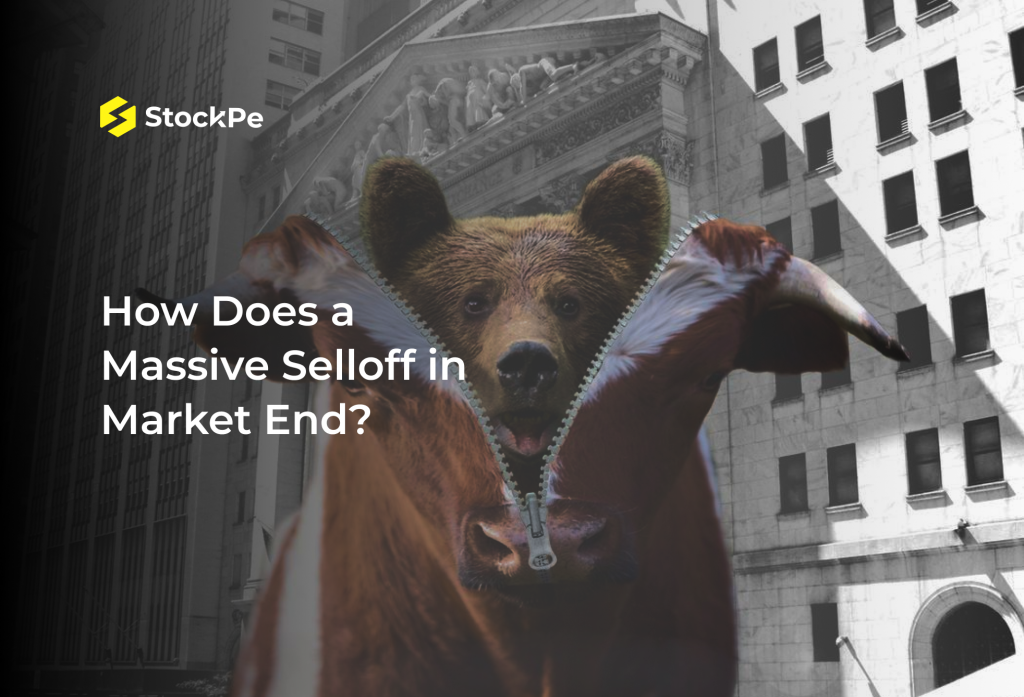Introduction: How a Major Market Selloff Comes to an End
The global financial markets frequently fluctuate, passing through periods of growth and decline every now and then. These occasional fluctuations escalate into a significant selloff igniting panic and turmoil amongst the investors. Investor’s sense of panic as a result of a market selloff frequently results in an increase in volatility. As additional members sell their property, the stock of protections offsets the interest, making costs fall further. As fear and selling pressure increase as a result, this can set off a self-reinforcing cycle. We examine the intricacies of a significant market selloff, its causes, the effects on various stakeholders, and the factors that ultimately result in its resolution in this blog. By understanding the elements at play during such a wild period, we can acquire important experiences into the strength and flexibility of the market.

The Market Selloff’s Causes
An enormous market selloff can be brought on by a number of different things, such as economic uncertainty, geopolitical tensions, or even unforeseen occurrences like natural disasters. Let us look at the primary causes for the sudden increase in interest rates by the central bank due to concerns about inflation. Investors are usually shaken by this move, which leads them to lose faith in the stability of the market.
A wide range of stakeholders are impacted by the ramifications of a massive selloff. Fear grips the market, prompting panic selling, as investors witness their holdings’ value fall. Stock prices will fall, making it harder for businesses to raise money and possibly affecting their growth plans. Retirees and pension funds bear the brunt of decreased retirement savings. On the other hand, employees may be uncertain about their job security.
As a result of this economic downturn, authorities in charge of the government must take steps to restore market stability. In order to restore an investor’s confidence, they might think about injecting liquidity, loosening monetary policy or implementing regulatory reforms.
Recovery and Resolution
In the midst of the chaos, the market begins to regain its footing as reason takes control. Realizing that the sell-off has created appealing buying opportunities, bargain hunters step in. The market is stabilized by this influx of demand for assets that are undervalued.
Regulators and central banks act quickly to restore investor confidence. They take steps to ease monetary policy, such as lowering interest rates or using quantitative easing, and they guarantee support. These intercessions plan to lighten monetary pressure and energize speculation. In addition, rebuilding trust requires open communication from regulatory authorities. They reassure participants in the market about the financial system’s long-term stability and provide clarity on the actions taken to address the underlying issues.
Bit by bit, as financial backers recapture certainty, the market bounces back. Positive monetary pointers, for example, hearty corporate profit or indications of expansion facilitating, additionally add to the recuperation. Financial backers start reinvesting in values, pushing stock costs higher. Positive sentiment spreads as the market gains momentum, increasing liquidity and reviving the economy as a whole.
Because of its potential in significant losses for investors and to cause economic instability, a significant selloff in the market is typically not regarded as a positive event in the short term. A selloff, on the other hand, can be a necessary correction that brings prices back in line with the economy’s fundamentals in the larger context of the market cycle.
Consider these factors regarding the impact and potential effects of a massive selloff:
- Short Term Effect: An investor’s panic and a negative feedback loop can result in a market selloff that further lowers prices. Investor confidence may be eroded as a result, resulting in a decrease in consumer spending, business investments, and economic activity as a whole.
- Costs to investors: Investors may suffer significant losses as the value of their holdings decreases during a selloff. Individual investors, institutional investors, pension funds, and retirees who rely on their investments for income or future financial security may be affected by this.
- Problems in the economy: Wider repercussions for the economy can result from a massive selloff, including fewer investments made by businesses, fewer job losses, and lower tax revenues for governments. Additionally, it may have an effect on consumer sentiment and spending patterns, resulting in a slowdown in economic expansion.
- Opportunities to Purchase: A selloff can, on the plus side, present long-term investors with buying opportunities. Undervalued securities become available when asset prices fall significantly, allowing investors to purchase assets at lower prices.
- Potential for Long-Term Growth: While a selloff can be disrupting, it is vital to recall that markets have generally recuperated and proceeded to accomplish new highs. Long haul financial backers who stay contributed during violent periods have frequently profited from resulting market bounce back and times of supported development.
A huge selloff in the market is without a doubt a wild and testing period for financial backers and different partners. However, history has demonstrated that recovery and sustained growth frequently follow such episodes. The collective efforts of regulators, investors, and other market participants to restore confidence and stability make up the market’s resilience. We can better navigate the financial world’s complexities, reduce risks, and seize opportunities even in the face of a massive selloff by learning from these experiences.





